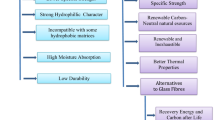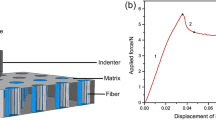Abstract
The thermal and mechanical stability of SiC fibers at elevated temperature is an important property for the practical application of SiC fiber-reinforced ceramic matrix composites and is related to the heat-treating atmosphere. In this study, the high-temperature behavior of KD SiC fibers with low oxygen content was investigated in both Ar and N2 at temperatures from 1400 to 1800 °C through scanning electron microscopy, X-ray diffraction, X-ray photoelectron spectroscopy, Auger electron spectroscopy, resistivity measurements, and tensile tests in order to understand the effects of atmospheres on the degradation of the fibers. The results show that high-temperature treatment caused more severe strength degradation in Ar than in N2. In particular, the fibers heat treated in N2 at 1700 °C retained a relatively high strength of 1.52 GPa, 60 % of their original strength, while the fiber strength was completely lost after heat treatment in Ar. Fiber strength degradation was mainly caused by a combination of crystal growth and surface flaws. The formation of huge grains and porosity in the fiber surfaces, owing to the thermal decomposition of the SiC x O y N z and SiC x O y phases, significantly degraded the strength for fibers heat treated in Ar. However, the suppressing effect of N2 on the decomposition of the SiC x O y N z phase in the fiber surfaces and nitrided case on the decomposition of the SiC x O y phase in the fiber cores, led to higher SiC fiber temperature stability in N2 rather than Ar.









Similar content being viewed by others
References
Schmidt S, Beyer S, Knabe H (2004) Advanced ceramic matrix composite materials for current and future propulsion technology applications. Acta Astronaut 55:409–420
Schawaller D, Clauß B, Buchmeiser MR (2012) Ceramic filament fibers: a review. Macromol Mater Eng 297:502–522
Kister G, Harris B (2002) Tensile properties of heat-treated Nicalon and Hi-Nicalon fibers. Compos Part A 33:435–438
Zhao S, Zhou XG, Yu JS, Mummery P (2013) Effect of heat treatment on microstructure and mechanical properties of PIP-SiC/SiC composites. Mater Sci Eng A 559:808–811
Zhao S, Yang ZC, Zhou XG (2015) Microstructure and mechanical properties of compact SiC/SiC composite fabricated with an infiltrative liquid precursor. J Am Ceram Soc 98:1332–1337
Bunsell AR, Piant A (2006) A review of the development of three generations of small diameter silicon carbide fibers. J Mater Sci 41:823–839. doi:10.1007/s10853-006-6566-z
Shimoo T, Chen H, Okamura K (1994) High-temperature stability of Nicalon under Ar or O2 atmosphere. J Mater Sci 29:456–463. doi:10.1007/BF01162506
Sha JJ, HinokiÆ ÆT, Kohyama A (2007) Microstructural characterization and fracture properties of SiC-based fibers annealed at elevated temperature. J Mater Sci 42:5046–5056. doi:10.1007/s10853-006-0579-5
Shimoo T, Okamura K, Takeuchi H (2003) Effect of reduced pressure on oxidation and thermal stability of polycarbosilane-derived SiC fibers. J Mater Sci 38:4973–4979. doi:10.1023/B:JMSC.0000004421.67094.2e
Shimoo T, Okamura K, Morita T (2004) High temperature exposure of low-oxygen SiC fibers (Hi-Nicalon) in CO-CO2 gas mixtures. J Mater Sci 39:7031–7039. doi:10.1023/B:JMSC.0000047548.81028.e1
Yao RQ, Feng ZD, Chen LF, Zhang Y, Zhang BJ (2012) Oxidation behavior of Hi-Nicalon SiC monofilament fibers in air and O2-H2O-Ar atmospheres. Corros Sci 57:182–191
Shimoo T, Okamura K, Morita T (2003) Thermal stability of low-oxygen silicon carbide fibers (Hi-Nicalon) in carbon monoxide. J Mater Sci 38:3089–3096. doi:10.1023/A:1024721128931
Shimoo T, Okamura K, Hayatsu T (1996) Effect of atmosphere on pyrolysis of Nicalon. J Mater Sci 31:4407–4413. doi:10.1007/BF00356468
Bender BA, Wallace JS, Schrodt DJ (1991) Effect of thermochemical treatments on the strength and microstructure of SiC fibers. J Mater Sci 26:970–976. doi:10.1007/BF00576774
Porte L, Sartre A (1989) Evidence for a silicon oxycarbide phase in the Nicalon silicon carbide fiber. J Mater Sci 24:271–275. doi:10.1007/BF00660966
Yamamoto K, Koga Y, Fujiwara S (2001) XPS studies of amorphous SiCN thin films prepared by nitrogen ion-assisted pulsed-laser deposition of SiC target. Diam Relat Mater 10:1921–1926
Shimoo T, Okamura K, Ito M, Takeda M (2000) High-temperature stability of low-oxygen silicon carbide fiber heat-treated under different atmosphere. J Mater Sci 35:3733–3739. doi:10.1023/A:1004856725352
Cao SY, Wang J, Wang H (2013) Synthesis, characterization and ceramization of a liquid hyperbranched polycarbosilane with vinyl groups. Rare Met Mater Eng 42:380–382
Wang DY, Song YC, Li YQ (2012) Effect of composition and structure on specific resistivity of SiC fibers. Trans Nonferrous Met Soc China 22:1133–1139
Yao RQ, Wang YY, Feng ZD (2008) The effect of high-temperature annealing on tensile strength and its mechanism of Hi-Nicalon SiC fibers under inert atmosphere. Fatigue Fract Eng Mater 31:777–787
Shimoo T, Tsukada I, Seguchi T, Okamura K (1998) Effect of firing temperature on the thermal atability of low-oxygen silicon carbide fibers. J Am Ceram Soc 81:2109–2115
Jian K, Wang H (2015) Evolution and controlling of defects during the preparation of continuous high-temperature resistant SiC(Al) fibers. Int J Mod Phys B 29:1540016 (1–7)
Acknowledgements
This work is supported by the National Natural Science Foundation of China (Grant Nos. 51172280 and 51403233), the Aid Program for Science and Technology Innovation Research Team in Higher Educational Institution of Hunan Province, and the Aid Program for Innovation Group of National University of Defense Technology.
Author information
Authors and Affiliations
Corresponding author
Rights and permissions
About this article
Cite this article
Cao, S., Wang, J. & Wang, H. High-temperature behavior and degradation mechanism of SiC fibers annealed in Ar and N2 atmospheres. J Mater Sci 51, 4650–4659 (2016). https://doi.org/10.1007/s10853-016-9780-3
Received:
Accepted:
Published:
Issue Date:
DOI: https://doi.org/10.1007/s10853-016-9780-3




